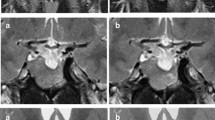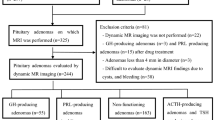Abstract
Adenomas causing acromegaly represent at least a quarter of pituitary adenomas. We studied 12 patients presenting with active acromegaly due to a pituitary adenoma with a 1.5 T superconductive MRI unit. All had T1-weighted sagittal and coronal sections before and after Gd-DTPA; six had coronal T2-weighted images. Surgical correlation was obtained in seven patients. Histologically, there were eight growth hormone (GH)-secreting and three mixed [GH and prolactin (PRL) secreting] adenomas, and one secreting GH, PRL and follicle-stimulating hormone. Macroadenomas (10) were more frequent than microadenomas (2). No correlation was found between serum GH and tumour size. There were nine adenomas in the lateral part of the pituitary gland; seven showed lateral or infrasellar invasion. Homogeneous, isointense signal on T1- and T2-weighted images was observed in six cases. Heterogeneous adenomas had cystic or necrotic components.
Similar content being viewed by others
Author information
Authors and Affiliations
Additional information
Received: 29 April 1996 Accepted: 8 August 1996
Rights and permissions
About this article
Cite this article
Marro, B., Zouaoui, A., Sahel, M. et al. MRI of pituitary adenomas in acromegaly. Neuroradiology 39, 394–399 (1997). https://doi.org/10.1007/s002340050431
Issue Date:
DOI: https://doi.org/10.1007/s002340050431




